Mention the word Uzbekistan and thoughts of the ancient silk road immediately comes up. Cities such as Bukhara and Samarkand have been etched into many a wanderluster’s minds as being synonymous to adventure and the exotic. These days, Uzbekistan is a frequently touristed destination, though nowhere near popular places such as Thailand or even India. This particular itinerary shows you how you can do the main silk road cities of Uzbekistan in just one week.
Tip: When entering Uzbekistan, you will need to declare exactly how much cash and valuables with you. The key is that after your trip, you should not leave the country with more foreign currency or precious metals than what you came in with. It may be quite a hassle upon arrival as it causes a bit of a queue at customs.
Table of Contents
Day 1 – Tashkent
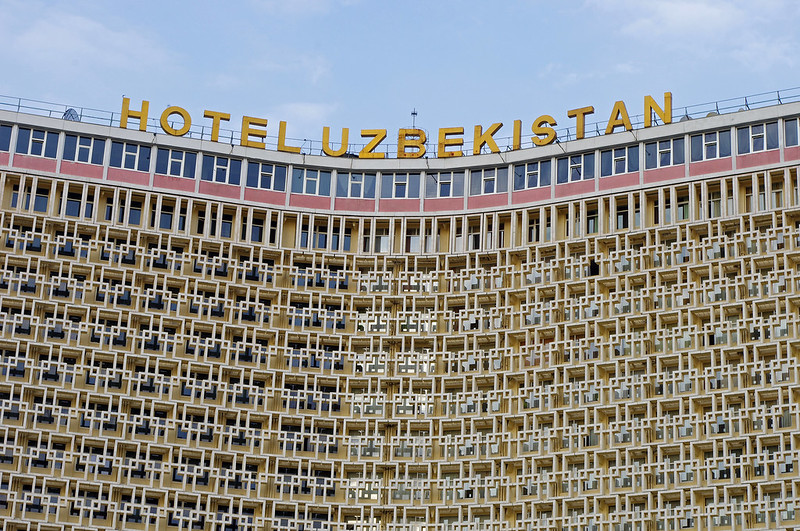
hotel uzbekistan in tashkent
The default entry point to Uzbekistan is its capital, Tashkent. One of the oldest cities in Central Asia, few of the ancient buildings remain after the Soviets came to modernize the city. The Tashkent of today is filled with brutalist architecture that serves to remind its communist past. You will find plenty in the city center including the imposing Hotel Uzbekistan which for years was the preeminent hotel in the capital. No trip to Tashkent is complete without stopping by the Chorsu Bazaar where you’ll find plenty of spices and dried fruit for sale. It is a functional market where you can also buy fresh meat and vegetables but the section that will interest tourist is the dry area.
End the day by watching a performance from the Navoi Theater. Built in the neoclassical style, tickets to a ballet or opera performance here are markedly cheaper than in Moscow.
Where to eat: National Food (Milliy Taomlar) is a popular place to go to eat especially during your first day in Uzbekistan. You’ll find plenty of traditional eats (including horse meat) by the entrance so if you don’t know how to order, you can just take your pick from the display.
Stay: One of the top choices in Tashkent is the Lotte Hotel City Palace located just opposite the Navoi Theater. One of the few hotels in the city of international standards.
Day 2 to 3 – Khiva
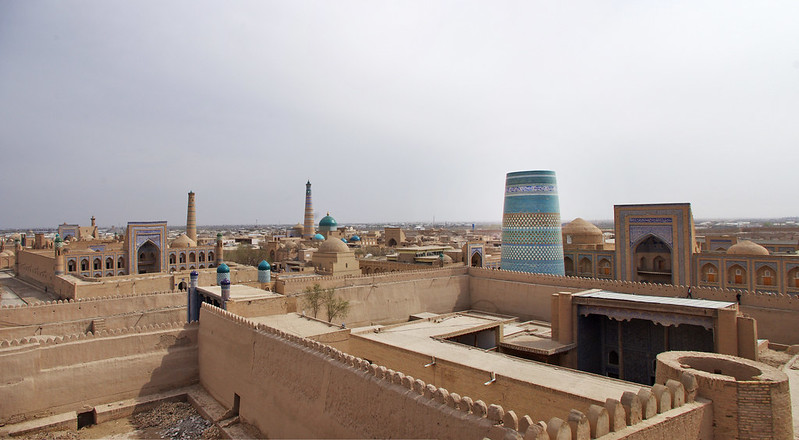
overlooking the old city of khiva
Take a domestic flight and fly to Khiva in the morning. This isolated city lying in the middle of the desert is one of the most atmospheric in Uzbekistan and should not be missed even though it’s out of the way. The city is divided between the Itchan Kala or the Walled City and the area outside of the wall. The bulk of the historic sights are located within the walls so it may be better to choose a hotel located inside.
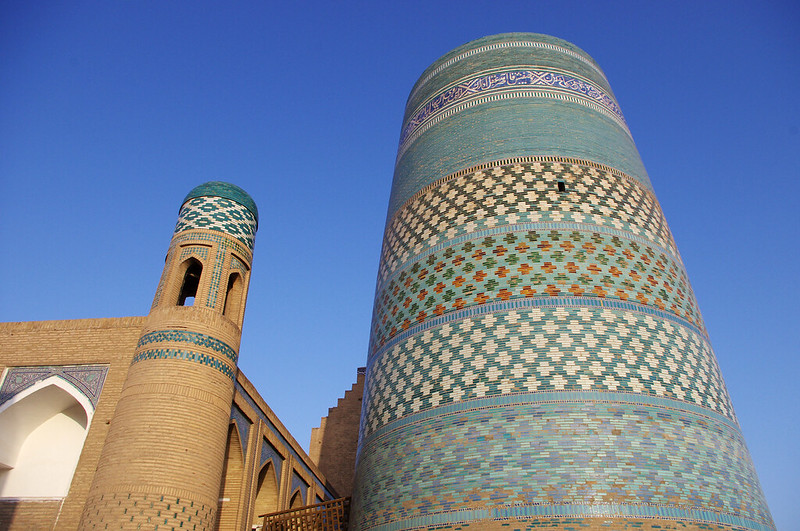
the unfinished minaret
Places to visit:
- The Kalta Minor minaret with its beautiful baby blue hues is one of the most striking attractions in Khiva. It was constructed in the 19th century but the architect escaped before its completion as he feared persecution by the Khan at the time.
- The Juma Mosque is particularly notable for its wooden beams which have plenty of intricate carvings.
- The 45 meter high Khoja Minarest is the tallest structure within the walled city. Visitors can climb to the top for a fee but claustrophopic people may find the narrow path uncomfortable. On good days, you can even see Turkmenistan in the distance.
- Make sure to climb up to the viewpoint in the Kuhna Ark for a wonderful vista of the old town.
- The Tash Chauli which used to be the khan’s palace has 160 rooms and a maze of corridors. The complex offers a peek at royal life in the old city.
- Head out to the East Gate with the statue of Al Khwarezmi, the founder of algebra and where the word “algorithm” originates.
Stay: Orient Star Khiva is a hotel converted from an old madrassah. The guest rooms are converted from old student dormitory cells and staying in one gives a real “Aladdin” kind of feel. Its location squarely in the old town makes it highly convenient if you are in Khiva for sightseeing.
Getting From Tashkent to Khiva: The best way to get to Khiva from Tashkent is by taking a domestic flight to the city of Urgench. Uzbekistan Airways flies there for about US$60 to US$70 per person and the flight lasts roughly 90 minutes. From Urgench, Khiva is approximately 40 minutes by taxi.
You can also check out a more comprehensive guide to Khiva HERE
Day 4 to 5 – Bukhara
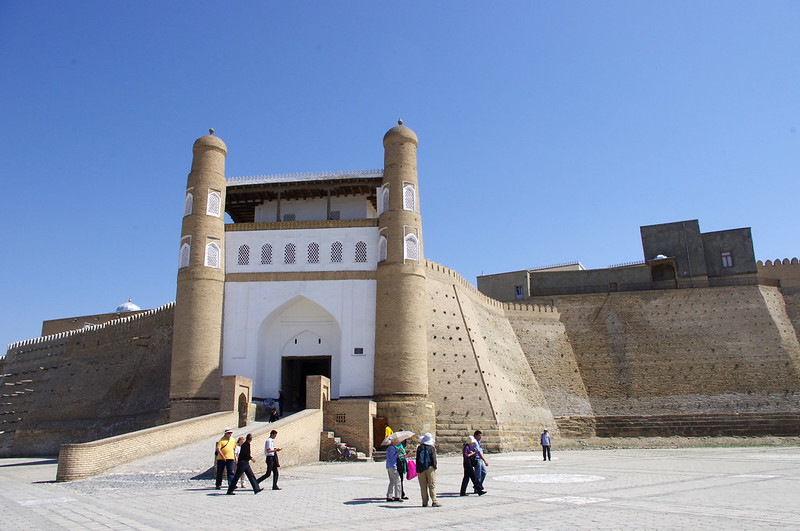
the ark fortress in bukhara
From Khiva, you can either drive to Bukhara or take a domestic flight. Do note that there aren’t daily flights between these two cities so if you plan to head out on a day where there are no flights, your only choice would be to drive. The road between Khiva and Bukhara is bumpy at certain points so do allow around a 7 hour journey time.
Tip: If you are going by land from Khiva to Bukhara or vice versa, ask your taxi driver to make a detour to the ancient fortresses of Tuprakkala. This will prolong your land journey for around 2 hours but is worth the extra time.
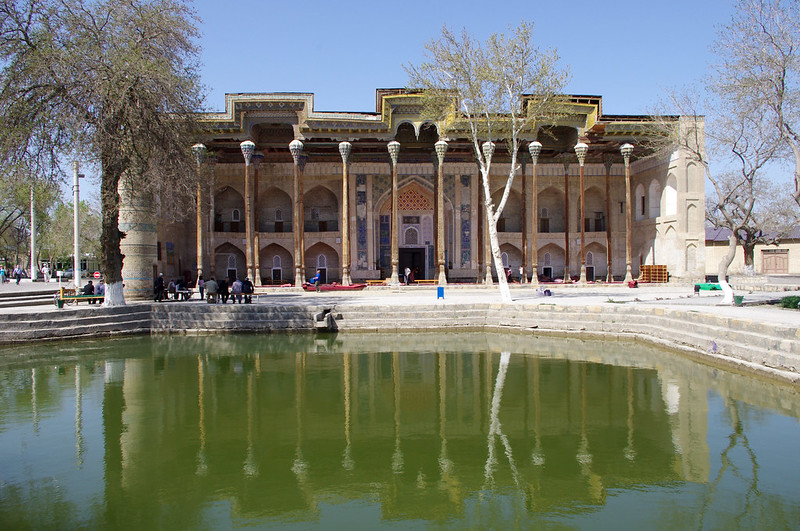
bolo hauz mosque in bukhara
The name Bukhara conjures vivid images of the ancient silk road and for good reason. The city has exchanged hands between several empires including Persian, Mongol and Russian. The rich cultural heritage is evident today in the beautiful ensemble of elaborattely decorated buildings in the center of town, mausoleums, fortresses and gardens.
Places to visit:
- Kalon Ensemble (Poi Kalan) – The jewel of Bukhara, the Kalon ensemble consists of the Mir-i-Arab Madrassa, Kalon Mosque as well as the Kalon Minaret. For many years, the latter was known as the tower of death as criminals were executed by being thrown out of the minaret, falling to their deaths.
- Lyabi Hauz – it used to be a pond where the city’s source of water came from. Today, it has been turned into a city park and you can find people hanging around here on good days. There are two old madrassas on either side of the pond and one has been converted into a restaurant.
- Samanid Mausoleum – Although the baked brick construction of the mausoleum may fail to equal the grandoise baby blue tiled works of Uzbekistan’s other ancient sites, the Samanid Mausoleum dating from the 9th century is frequently cited as one of the best works of early Persian architecture in the country.
- Chasma Ayub – also known as Job’s well. Legend has it that the biblical figure, Job, came here and made a well by striking the ground with his staff. To this date, the well still exists and people come here in order to soak the water in various parts of their bodies to be healed.
- Bolo Hauz – this open-air mosque sits opposite the Ark Fortress and used to be the Friday Mosque in the city.
- Abdul Aziz Khan Madrassa
- Chor Minor – Sometimes missed out of walking tours of Bukhara due to its location further east, the Chor Minor is notable for its four minarets. The building has served various functions over the years including as a mosque and madrassa.
- Ark Fortress – currently functioning as a museum, the Ark Fortress used to house the court of the former rulers of Bukhara. The fortress was last used for its original purpose in 1920 when the Russian Army came to integrate Uzbekistan into what would become the USSR.
Where to Shop: Taqi Sarrafon and the Taqi Telpak Furushon within the old town are places to go for souvenirs and traditional Uzbek goods.
Stay: The Amelia Hotel remains to be one of the top ranked boutique hotels in Bukhara. It’s one of the first hotels in the city to try to mimic the madrassa look inside the rooms – a few other similarly-styled hotels have since sprouted in town.
You can also check out a more comprehensive guide to Bukhara HERE
Day 6 to 7 – Samarkand
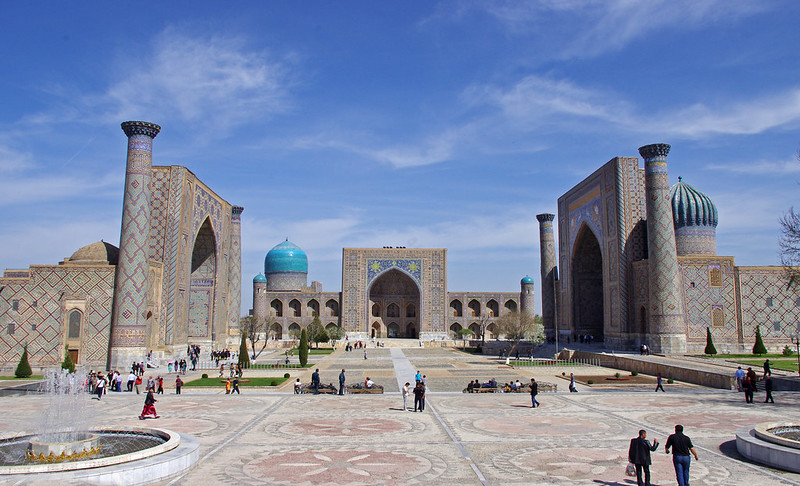
the registan in samarkand
Another city that conjures up images of the ancient silk road, Samarkand today is bigger and more modern than Bukhara or Khiva. The city’s centerpiece is undoubtedly the beguiling Registan. The monuments here are noticeably grander but these are also more spread out.

gur e amir in samarkand
Places to visit:
- Registan – Probably the finest cultural ensemble in all of Uzbekistan, the Registan is a collection of three buildings with two facing each other. Of note is the Tilya Kori Madrassa which has a fake gilded dome (meant to be an optical illusion). Do note that the Registan is also floodlit at night and the only way to access it in the evenings is to go for the nightly concerts which cost only $5 and gives you access to the square.
- Shah i Zinda – an old burial site with more than 20 buildings including some elaborate mausoleums
- Gur-e-Amir – one of the most important among the numerous mausoleums in Uzbekistan, the Gur-e-Amir houses the remains of Tamerlane. Inside, you’ll find some of the most intricate muqarnas in Uzbekistan.
- Bibi Khanym Mosque – part of the UNESCO World Heritage Site, the mosque today mostly lay in ruins. It used to be one of the most important mosques in the city.
Tip: If time permits, stop over at the city of Shahrisabz which is around 1.5 to 2 hours away. A UNESCO World Heritage in its own right, Shahrisabz is known as the birthplace of Tamerlane. Here, you’ll also find his summer palace as well as the tomb of Jahangir and a second tomb for Tamerlane.
Stay: The Grand Samarkand Hotel is one of the most established hotels in the city and it’s located in an upmarket area not too far from the Registan.
You can also check out a more comprehensive guide to Samarkand HERE
Day 8 – Tashkent
Head back to Tashkent before catching your flight back to your city of origin. You can choose to kill some time at the main shopping street which for some reason, is called Broadway or hang around Amur Timur Square for a glimpse of local urban life.
Other Travel Tips For Uzbekistan
- Travel insurance: It may be advisable to get travel insurance, especially if you plan to do adventure activities. If you come from Singapore, I can recommend checking out Starr TraveLead for its cheap single- trip travel insurance with S$10 cash rebate to help offset the insurance cost here. If you are based elsewhere, check out Worldnomads as they have quite an extensive coverage, even including personal accidents into their list of benefits.
- Weather: The best time to visit Uzbekistan is from September to October. This is autumn season and you’ll find an abundance of local fruits and vegetables. Uzbekistan is known for its melons / watermelons which ripen at around this time. You’ll find sweet watermelons wherever you go, sometimes nearly for free! The next best time to visit is from April to June. Avoid visiting during July and August unless you do not mind the sweltering heat.
- Changing money: Money exchange offices are commonplace in the main tourist cities of Tashkent, Samarkand, Khiva and Bukhara. The rate is usually quite favorable, being at or near the actual spot rate for USD or Euro.
- Language: The most commonly spoken foreign language in Uzbekistan is Russian but English is increasingly used in cities like Tashkent, Khiva, Samarkand and Bukhara. Among Central Asian nations, Uzbekistan is probably the most proficient in English.






Leave a Reply